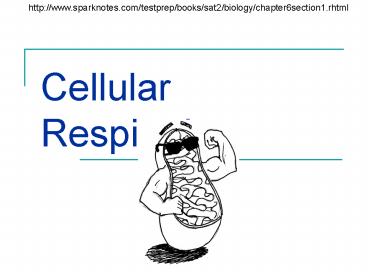Cellular Respiration - PowerPoint PPT Presentation
1 / 18
Title: Cellular Respiration
1
Cellular Respiration
http//www.sparknotes.com/testprep/books/sat2/biol
ogy/chapter6section1.rhtml
2
Cellular Respiration
- The process by which the mitochondria breaks down
glucose to produce ATP is called cellular
respiration.
C6H12O6 6O2 ? 6CO2 6H2O
3
Cellular Respiration
- When the body has oxygen, aerobic respiration can
take place and produce 38 energy molecules. - There are 3 stages of aerobic respiration
- Glycolysis
- Citric acid cycle
- Electron transport chain
4
Glycolysis
- Glycolysis takes place in the cytoplasm of the
cell.
5
Glycolysis
- Glycolysis is the process where glucose is broken
down in 2 pyruvic acid molecules. Pyruvic acid
is a 3 carbon molecule. - The net gain of ATP molecules in glycolysis is 2
ATP molecules.
4 -2 2
6
Glycolysis
- Following glycolysis, the pyruvic acid moves into
the mitochondria.
7
The Citric Acid Cycle
AKA Krebs cycle
- The Krebs cycle takes place in the MATRIX!
- Pyruvic acid enters the citric acid cycle and
becomes broken down. As this occurs, 2 carbon
dioxide molecules are released. - In addition, 2 ATP molecules are released.
- Electron carriers such as FAD and NAD are used to
pick up energized electrons and pass them to the
ETC.
8
(No Transcript)
9
In a nutshell
FYI Flavin adenine dinucleotide Nicotinamide
adenine dinucleotide
10
The Electron Transport Chain
- The last step of respiration is the electron
transport chain or ETC. - It takes place in the inner membrane space.
- In the presence of oxygen, the electron transport
chain will produce 32 ATP molecules and water. - The grand total of ATP molecules released from
AEROBIC respiration is 36.
36
36
38
38
11
Electron Transport Chain
- Electron carriers NADH and FADH2 release the
Hydrogen ions across the membrane. This creates
a concentration gradient. - When oxygen enters the ETC, it becomes the final
electron acceptor of the Hydrogens and creates
H2O. - As the hydrogen ions come back across the
membrane, ADP is converted into ATP.
BEST and SIMPLE http//www.science.smith.edu/depa
rtments/Biology/Bio231/etc.html
http//vcell.ndsu.nodak.edu/animations/etc/movie
.htm http//highered.mcgraw-hill.com/sites/007243
7316/student_view0/chapter9/animations.html
12
Electron Transport Chain
- Electron carriers NADH and FADH release the
Hydrogen ions to proteins to cross the membrane.
This creates a concentration gradient. - When oxygen enters the ETC, it becomes the final
electron acceptor of the Hydrogen ions and
creates H2O. - As the hydrogen ions come back across the
membrane, ADP is converted into ATP.
13
THE BIG PICTURE
14
Anaerobic Respiration
AKA Fermentation
- There are times when cells are without oxygen for
a short period of time. When this happens,
anaerobic respiration is taking place. - In anaerobic respiration, the first 2 steps of
respiration will take place however, the ETC
will not take place. - The grand total of ATP molecules released will be
4.
15
Types of Anaerobic Respiration
- When our cells run out of oxygen and begin
fermentation, we build up lactic acid. That
lactic acid build up in the muscle makes us feel
a cramp. - C6H12O6 ? ATP lactic acid
Lactic Acid Fermentation
16
Types of Anaerobic Respiration
- Some bacteria also undergo fermentation. They
release ethyl alcohol and carbon dioxide. - C6H12O6 ? ATP CO2 ethyl alcohol
- This process is key for the bacteria that create
wine and apple juice.
Alcoholic Fermentation
17
Types of Anaerobic Respiration
- Yeast also undergo this type of fermentation when
making bread.
18
Comparing Photosynthesis and Respiration
Respiration
Photosynthesis
- Glucose made
- Light energy required
- ATP broken down in 2nd phase of p.s.
- CO2 taken in
- O2 released
- Needs water
- Takes place in chloroplast
- Takes place in autotrophs
- Glucose broken down
- Light is not required
- Energy created in ATP
- CO2 released
- O2 taken in
- Water released
- Takes place in mitochondria
- Takes place in all organisms
- Require use of ATP molecules
- Take place in plants
- Necessary to sustain all life on earth































